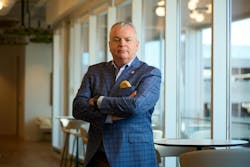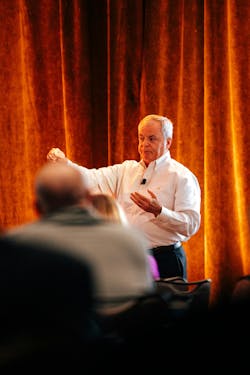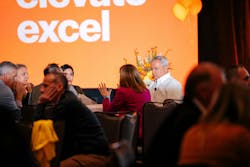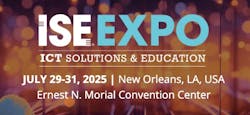Executive Insights with ISE EXPO’s Closing Keynote Presenter, Tom Maguire, Founding Leader and Board Member, Brightspeed
This Non-Telecom Acronym Says It All: WYSIWYG (What You See Is What You Get)
There’s a reason we’ve asked Tom Maguire to deliver a keynote not once, not twice, but three times: he represents exactly what we value in network evolution. It’s not just about staying current—it’s about learning, doing, reflecting, and bringing others along for the ride.
Tom understands that data matters, but data alone isn’t enough. Real progress happens when people learn from experience and from those they trust and respect.
What sets Tom apart? He’s honest. He takes risks. He owns his mistakes—and grows from them. He leads with integrity, whether the spotlight is on him or not.
That’s why he’s back. Trust me. You don’t want to skim this read.
P.S. Learn from him live and in person at his ISE EXPO 2025 keynote presentation, Thursday, July 31, 2025. Register today at www.iseexpo.com.
Topic: Convergence and Hybrid Networks
ISE: You have partnered with Verizon to launch an FWA solution and plan to expand your reach to more than 5 million locations across our 20-state footprint. What other network technologies do you intend to utilize soon?
Tom Maguire: This is an interesting question; one I ask myself and the team quite frequently. The easy answer is “all of them” depending on the area of our business we’re talking about.
I consider our footprint split into three territories: fiber-now, fiber-future and copper-only.
Fiber-now areas already have the best technology you can buy in fiber. So, our goal is to build out as quickly as possible to the areas we know we can efficiently reach with our fiber network. Additionally, fiber can support using small cell technologies that connect at the edge of our fiber network, expanding our reach further.
In fiber-future areas, we plan to deploy our fiber network, so it doesn’t make sense to invest in rehabbing or replacing the existing copper. These areas are where we look at alternative technologies that are more cost-effective and efficient. We’ve had a wireless solution for voice with several carriers, but we needed to develop a solution for data, hence the agreement with Verizon. We are also talking to other wireless carriers about accessing their service for alternative broadband solutions. We need to work with the nation’s wireless carriers to ensure full coverage throughout our footprint. Our fixed wireless voice and data solution is carrier agnostic—working with any wireless network. Our one-box solution is easier to maintain and repair.
For the areas where we will only have copper service available and will remain copper-only, we can deploy our fixed wireless voice and data solution. However, some areas do not have strong wireless coverage or connectivity. It may be best to partner with a low-earth orbit (LEO) satellite service provider for those areas. We’ve been talking to a few of these service providers about a potential partnership.
We aim to deliver the best service available to the customer without investing in an aging copper network that cannot meet today’s needs.
Things are very different today thanks to new technologies like FWA and LEOs. Also, overbuilders, MVNOs, and new players are entering the fray.
Topic: Copper Retirement
ISE: Speaking about copper areas, Brightspeed supports the FCC’s recent actions1 to help “accelerate the transition from aging copper lines to modern network infrastructure in communities nationwide. These actions will help providers roll out upgraded, high-speed networks to more Americans faster, rather than requiring providers to keep pouring resources into maintaining decades-old and increasingly expensive copper line networks.” Share a few challenges Brightspeed faces in this area and the solutions your teams used to overcome those challenges.
Maguire: We were heading into the pandemic when we started launching what was to become Brightspeed in 2020. This contributed to significant construction challenges, including the lack of talent and supply chain disruptions. In addition, we didn’t even have a name—we were an unknown brand. We were just three retired guys working with a private equity firm looking to build 3.7 million fiber prems.
There was already a shortage of outside plant technicians and fiber splicers, so using materials that were easy to deploy with minimal splicing made sense. That’s why we started working with Corning to use their Evolv and Pushlok products. These products are super lightweight and connector-enabled, reducing the need for things like over-lashing, make-ready work, and splicing.
We also eliminated the centralized fiber distribution hub (FDH), which reduced splicing during the construction phase and eliminated potential future pain points. Since everything is nailed up from the OLT to the serving terminal, it eliminates the risk of accidentally pulling jumpers or future recordkeeping issues.
Additionally, we established a GIS engineering platform and used regional contractors with standard rate cards rather than bidding individual jobs.
We did a great job addressing the main construction challenges.
Even though the FCC under Chairman Carr recently helped advance decommissioning through lighter regulatory requirements that speed up the process, we still have to navigate local regulatory and operational challenges, such as permitting and antiquated Carrier of Last Resort (COLR) obligations.
The Brightspeed Government Affairs team establishes relationships with local regulators and municipalities to reduce or eliminate COLR obligations that significantly burden historical ILECs. They also set up processes to give the local municipalities ample time to get us the clearances we need to build the fiber that enables us to retire copper and better serve our customers.
We continuously improve by evaluating potential or perceived pain points and reprioritizing. We are constantly working toward greater efficiency across the enterprise. Overcoming the challenges in our industry definitely takes a village.
Topic: Lessons Learned
ISE: Brightspeed has received more than $240 million in local, state, and federal broadband grants and funding, including the state of Louisiana’s first Broadband Equity, Access, and Deployment (BEAD) Program award.2 These investments will expand the company’s planned network by nearly 139,000 locations in 14 states. Share the best practices you recommend for improving community partnership programs. Conversely, what are two practices others should avoid?
Maguire: In my mind, community partnerships are not closely connected to the subsidy programs.
Subsidies are awarded based on applications that consider factors such as the number of premises you build, their associated costs, the technology and data speeds being provided, etc. This is where all the enhancements come into play. If our cost per premises passed (CPP) is low, we can build more.
As for community partnerships, those are led by our marketing efforts. Local sponsorships, especially for events that families can enjoy, are important. For instance, we invest in local schools, public spaces, sports programs, arts organizations, entertainment events and other resources aimed at enhancing the communities we serve.
In either case, the best practice I recommend is developing relationships with decision-makers. Fostering relationships and supporting community leaders is essential because we can elevate communities together for mutually beneficial future growth.
Topic: Workforce Solutions
ISE: Brightspeed has hired, trained, and deployed 234 new techs. Share best practices Brightspeed uses to retain that talent.
Maguire: It all starts with one of our core values—people matter. Let the techs know they have a voice regarding methods and procedures and that their opinions matter. More importantly, incorporate that voice into policies and decision-making when it makes sense.
And I do not believe this is just a nice thing to do; I think it’s the right thing to do to improve your overall operational efficiency.
Topic: The AI Buzz Versus Network Realities
ISE: AI can optimize broadband networks through predictive maintenance and workload management. How is Brightspeed employing AI across its network?
Maguire: Brightspeed uses Vertex AI, Google Cloud’s all-in-one platform for building, training and deploying machine learning (ML) models—making AI development for the company easier, faster and more scalable. As a result, our ML models predict customer churn, forecast network outages, and automate field service routing, enabling smarter decision-making and creating opportunities for more proactive operations.
Brightspeed’s AI models are powered by BigQuery, Google Cloud’s super-fast, cloud-based tool for analyzing large amounts of data at lightning-fast speed—billions of rows of data in near real-time. This enables real-time insights into the company’s fiber network health, customer experience analytics, and fraud detection. Also, by combining location-based data with Google’s BigQuery, Brightspeed can now see where its fiber network reaches, plan where to build next, and understand how outages affect specific areas.
We have fully deployed Google’s AI-powered Contact Center as a Service (CCaaS) platform, the first in the telecom industry. Our AI-first approach uses intuitive virtual agents, smart call routing and advanced conversational AI to deliver personalized support and solutions in every customer interaction.
Integrating Google Cloud’s large language model (LLM) technology powers highly intelligent virtual agents capable of responding to customer inquiries with enhanced relevance, fluency and contextual understanding. Real-time AI insights assist our customer care agents during escalations by summarizing customer history and suggesting the next best actions, which minimize resolution time and maximize satisfaction.
Through deep AI-assisted integration with back-end systems, Brightspeed resolves customer inquiries from end to end, not providing just information but completing tasks like bill payments or service updates. This full-circle approach eliminates common frustrations such as surface-level answers or generic links, replacing them with actionable, complete solutions.
Our full implementation of Google Cloud’s CCaaS platform significantly increased customer self-service resolution rates. The platform’s key features, such as natural language-driven call routing and contextual sentiment recognition, ensure that every interaction, whether handled by a virtual or human agent, is intelligently directed for the most effective resolution.
Brightspeed’s AI-first strategy has created a smarter call center and a complete, integrated resolution ecosystem, delivering personalized, frictionless support across the enterprise and its network.
Topic: Resilient Infrastructure
ISE: When broadband infrastructure fails during disasters, everything from emergency response to healthcare delivery breaks down. Share three recommendations you can offer smaller broadband network providers as they are charged to ensure their networks are resilient.
Maguire:
- Consider resilience and ease of maintenance in your network architecture. Fiber is not as permeable to weather as copper and is the most reliable and fastest option. Plug-and-play maintenance options will allow for quicker repairs at lower costs when facilities are damaged.
- For our business customers, we offer network resiliency that enables our fiber routers to seamlessly shift to a wireless backup during a fiber outage. Once configured through the mobile app, customers can leverage their mobile phone or a hotspot. Many customers appreciate the resilience feature that supports their point-of-sale system.
- Lastly, anticipate network growth and future use and invest in the technology supporting it. Think about what people will need in the event of a disaster, like the COVID-19 pandemic. This is why we decided to nail up fiber all the way to the serving terminal. You do not want to create more work or incur added costs down the road after a disaster hits; try to avoid the pothole.
Beyond the network, go back to basics when dealing with customers regarding an outage. More communication is best. Be transparent and honest. We are working to give customers an improved experience with self-service tools and various communication channels to meet our customers where they are and where they want to communicate.
Topic: Permitting Reforms
ISE: The permitting process can be challenging, with varied federal, state, and local regulations. Share 3 to 5 best practices Brightspeed uses to ensure permitting issues don’t hinder its goal of deploying fiber networks across its footprint.
Maguire: Last year, Brightspeed helped sponsor a workshop with industry experts and local permitting officials to uncover the industry's and localities' pain points. The goal was to understand how to best address permitting challenges. This workshop resulted in a white paper, published by the Benton Institute: “Permitting Success: Closing the Digital Divide Through Local Broadband Permitting,” establishing model processes and best practices. Using these learnings as a baseline:
Brightspeed is:
- Fostering partnerships between the permit seeker and the permitting authorities.
- Maximizing resources available to the permitting authority.
- Ensuring transparency, consistency and early communication in the permitting process.
Local permitting authorities can do their part in securing broadband for their residents by implementing the following recommendations:
- Create single points of contact at the local government for permitting.
- Make permitting requirements available online, and allow for electronic document submission, electronic communication, tracking, etc., or utilize e-permitting platforms.
- Avoid duplication by:
- Allowing permit changes to be “in-process” instead of restarting the whole application when there is a change.
- Facilitating bulk permitting for similar types of work, larger geographic areas.
- Leveraging ISP resources to allow use of ISP inspections for post-permit completion.
- Reducing requirements in already analyzed areas.
Topic: Innovation
ISE: If you could wave a magic wand, what groundbreaking product or solution would you like to see introduced for fixed and mobile networks that would accelerate deployment?
Maguire: Because we do not own wireless spectrum, we need to rely on mobile virtual network operator/enabler (MVNO/E) partnerships or Citizens Broadband Radio Service (CBRS), such as free spectrum. We have considered CBRS, but the installation options are complex and costly. It would require technicians to climb on roofs, contractors to install equipment on towers, etc.
We need options, and our partners need to innovate with us to develop these options. We designed and built our fixed wireless voice and data device with unique capabilities (including an ATA for dial tone and a global eSIM). Now, we’re looking for a 5G device with an ATA or even one with LEO satellite capabilities.
If I could wave a magic wand, I would create stronger wireless coverage in the rural non-fiber markets and products that support 4G/5G, and LEO with an ATA. I would make those devices easy for us to dropship and for customers to self-install.
Topic: The Elephant in the Room
ISE: What is the broadband industry not addressing that it should?
Maguire: This is something else that keeps me up at night.
The world is very different today—not since my early days in the telecom business, but even since the launch of Brightspeed just a few years ago.
When we launched the company, customers had three choices for broadband: your ILEC, MSO, or wireless handheld devices for some customers.
Competition wasn’t a chip shot, but you could see who your competition was. It was a well-defined market.
Things are very different today thanks to new technologies like FWA and LEOs. Also, overbuilders, MVNOs, and new players are entering the fray.
As a result, we need to think and act differently as an industry. I’ve always advocated for cooperation amongst the telcos, but I think we need to crank that up a bit.
I do not have all the answers, but we must start framing the questions.
Topic: Company Culture
ISE: Culture affects almost every element of a company, and employees and leaders alike feel it daily. However, bridging the divide between executive leadership and the general workforce can sometimes be tough. What strategies do you employ, as CEO, to nurture Brightspeed’s company culture?
Maguire: I strongly believe in the old-school basics, such as following the Golden Rule and leading by example. These are very important to me.
I’ve worked for people who leaned heavily on the “do as I say, not as I do” approach to management. Those people don’t earn or deserve the respect of their teams.
Also, it is essential to check your ego at the door. When we launched Brightspeed, we had an unspoken rule that big egos don’t matter, and this starts at the top. Now I realize it is my responsibility to make tough decisions, but you need to do this with as much respect as the situation warrants. Sometimes, you need to be more pointed or direct because people may not be open to change. Other times, you just need to listen. I have learned in this industry that the one constant is change, especially now.
As a result, we need to think and act differently as an industry. I’ve always advocated for cooperation amongst the telcos, but I think we need to crank that up a bit.
Topic: Significant Learning
ISE: What is the most important thing you can teach people about your time in the C-Suite?
Maguire: Interestingly, people looked at me differently, which I got a kick out of. But this is an important realization because I had to think about everything I said and did. I was the example that people would follow.
I’ve seen many people in positions of authority who do not realize this, and that can be an issue. For example, an offhand remark I may have made about something not working as I imagined can trigger a team of employees poring through data and creating a detailed analysis. This is wasteful if I was just plain wrong in my understanding of the situation.
When leading large teams, it’s important to be mindful of your words and actions, as this can avoid unnecessary work.
Topic: Constant Growth
ISE: What soft skills and leadership strategies are essential for your team members to succeed in this ever-evolving industry?
Maguire: It’s important to know your audience. We do not live in a one-size-fits-all world. How I speak to a garage full of techs differs significantly from how I address our legislators on the Hill in DC.
Tailoring the message and delivery will help ensure the audience clearly understands and can interpret a clear call to action.
Topic: Significant Risks
ISE: What has been your most significant professional risk, and what did you learn from it?
Maguire: Taking on the CEO role may have been my most significant professional risk.
I had never been a CEO. That means I did not know everything I should, and I put my reputation on the line. It took me decades to build this reputation, both the good and bad parts.
I could have stayed peacefully in retirement, but when Bob Mudge called Chris Creager and me and said we could put the band back together, I didn’t hesitate for a moment.
Working with those guys, the Apollo team, and the rest of Brightspeed was well worth the risk, and I would do it again in a heartbeat.
Topic: Constant Growth
ISE: What new skills or knowledge are you on a mission to learn this year?
Maguire: Not Pickleball … or golf.
Topic: Leadership Style
ISE: Share one word that encapsulates your leadership style. Share one word that describes you when you’re not working.
Maguire: It’s not really a word, but I’ll use it for both work and play – WYSIWYG (what you see is what you get). I stole that from Lotus123 (which was the Excel of its time).
You may not always like what you see, but I’ll always try to be honest and open.
Topic: Balance
ISE: What are your thoughts about a work/life balance?
Maguire: I think my wife, Donna, is a saint.
I am a workaholic. In fact, it’s currently 7:30 at night and I’m still sitting in the office. Donna is my life balance. I owe everything I am to her. She kept the lights on when I was out working/playing in the “field.”
Topic: Legacy
ISE: What do you hope your professional legacy is when you’re comfortably retired on a tropical island?
Maguire: I hope people think I always tried to do the right thing for our customers and employees.
REFERENCES
1. FCC, https://docs.fcc.gov/public/attachments/DOC-410304A1.pdf
2. Brightspeed, https://www.brightspeed.com/brightspeed-news/Brightspeed_Augments_Multi-Billion-Dollar_Fiber_Network_Build_with_First_BEAD_Award.html
Tom Maguire is a company founder, senior advisor to the CEO, and a board member for Brightspeed. He is responsible for leading the strategic planning and implementation of the company’s strategy and goals, ensuring operational excellence and driving innovation across the enterprise. He oversees the company’s business development opportunities and customer-focused improvements and growth. Tom brings more than four decades of telecommunications experience to Brightspeed. Starting as a field technician, he built his career from the ground up. For more information, visit www.brightspeed.com.
Learn from him live and in person at his ISE EXPO 2025 keynote presentation, Thursday, July 31, 2025. Register today!
About the Author
Sharon Vollman
Content Ambassador for ISE EXPO
Sharon Vollman is the Content Ambassador for ISE EXPO. She is passionate about collaborating with thought leaders, SMEs and hard-working doers who design, plan and deploy ultra-reliable broadband networks. Vollman is committed to creating a variety of educational offerings for ISE EXPO attendees that inspire them to connect every U.S. citizen with the broadband networks we all want for our children and grandchildren.
Vollman has created educational partnerships with Broadband Service Providers including AT&T, Verizon, Lumen, Frontier Communications and others. She has covered the telecom industry since 1996.




